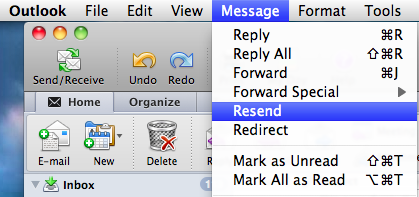

The second is what you'll see in Outlook 2003 with one line (slide the reading pane to the right to make it smaller or close the reading pane) or if using older versions of Outlook. The first menu is seen when you use Outlook 2003's new message list with the two line view and right click on any of the field names across the top. Right click on field names in Message list: Show the Advanced toolbar ( View, Toolbars, Advanced) and select a new view from the View selector or Define Views at the bottom of the list of views. View, Current View, Define views or Customize Current View Older versions of Outlook don't have the Arrange by menu so you'll go from View to Current View: View, Arrange by, Current View, Define views or Customize Current View You can use the View menu, the View selector tool on the Advanced toolbar or right click on the field names in the message list. Or apply the view to all folders using the command on the Change view menu. If you want to edit the view and have any chance that the view will apply to all fiddlers that use the view, edit the view using the Manage views dialog. Use the View settings button to edit the current view. (See Disable Group View for more information on designing views to apply to all folders.) Use this dialog to delete views or reset the view for all folders. Use the Manage views (formerly called Define views) to manage your views and edit a view so it applies to all folders that use that view. Expand the Change view menu to select a different view.Ģ. It's much easier to customize and reset views in Outlook 2010, thanks to the View ribbon.ġ. More information on which to choose is at the end of this article. Some of the menus offer two options: Define views or Customize Current View. Select the calendar icon at the bottom of the page to see the calendar.There are several ways you can access the dialog to customize or reset the views. It's not possible to show the calendar in the reading pane. Press and hold the Control key while clicking the mouse button. If you want to mark a read message as unread: They have bold type when the reading pane is hidden or positioned below the item list. Unread messages are marked with a blue dot and have a blue time and date when the reading pane is positioned to the right of the item list. How do I change the look of unread messages? If you'd like to request this feature, please visit the Outlook Suggestion Box. It's not possible to add or remove buttons on the ribbon in Outlook for Mac. You can't change the size of buttons at this time.
#Format menu in outlook for mac for mac#
See Change the font size in Outlook for Mac for instructions. How do I change the font size of the folder list and email list? Select Home > Filter, and then select an option. If your reading pane is set up to show messages on the bottom, right-click or Ctrl+click anywhere in the message column header section, and then select Arrange By > From.įilter email by unread, attachments, or date sent If your reading pane is set up to show messages on the right, at the top of your message list, click the By menu, and then select From. Whether your messages are set up to display on the right or on the bottom, you can organize email by sender simply by clicking the Arrange By menu on the Organize tab and selecting From. To resize a column, rest the pointer on the right edge of the column header until the pointer changes, and then drag the edge. To rearrange the columns, click a column heading, and then drag it to a new position. Columns in the current view are identified with a check mark.Ĭlick on a column heading to sort by that column.

Select View > Columns, and then click a column name. The available columns vary, depending on the type of items in the list.Ĭolumns work best when the reading pane is hidden or positioned below the item list, so select Organize > Reading Pane > Bottom or Off. Select Organize > Arrange By, and then select an option. To change the size of the reading pane, rest the pointer on the border between the reading pane and the message list, and then drag the border to the right or left.Ĭhange the sort order in the message list Select All Accounts in the upper left, and then click Inbox. Hover your mouse near the top of the screen to make the menu bar visible, or click the green button at the top left to leave full-screen mode. If you don't see the menu bar, you're probably in full-screen mode. Most customization options are available on the Outlook menu bar and ribbon. Outlook for Microsoft 365 for Mac Outlook 2021 for Mac Outlook 2019 for Mac Outlook 2016 for Mac More.


 0 kommentar(er)
0 kommentar(er)
